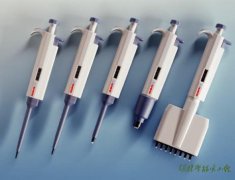
Rhodamine 123 (pron.: /ˈroʊdəmiːn/) is a chemical compound and a dye. It is often used as a tracer dye within water to determine the rate and direction of flow and transport. Rhodamine dyes fluoresce and can thus be detected easily and inexpensively with instruments called fluorometers. Rhodamine dyes are used extensively in biotechnology applications such as fluorescence microscopy, flow cytometry, fluorescence correlation spectroscopy and ELISA.
The absorption of Rhodamine 123 peaks around 505 nm and luminescence is tunable around 560 nm when used as a laser dye.[1] Its luminescence quantum yield is 0.90.[2]
References
This optical absorption measurement of Rhodamine 123 were made by R.-C. A. Fuh on 06-19-1995 using a Cary 3. The absorption values were collected using a spectral bandwidth of 1.0 nm, a signal averaging time of 0.133 sec, a data interval of 0.25 nm, and a scan rate of 112.5 nm/min.
These measurements were scaled to make the molar extinction coefficient match the value of 85,200cm-1/M at 511.8nm (Eastman, 1993).
Fluorescence
The fluorescence emission spectrum of Rhodamine 123 dissolved in ethanol. The excitation wavelength was 480nm. The quantum yield of this molecule is 0.9 (Kubin, 1982). This spectrum was collected by on 06-19-1995 using a Spex FluoroMax. The excitation and emission monochromators were set at 1 mm, giving a spectral bandwidth of 4.25 nm. The data interval was 0.5 nm and the integration time was 2.0 sec.
Samples were prepared in 1cm pathlength quartz cells with absorbance less than 0.1 at the excitation and all emission wavelengths to uniformly illuminate across the sample, and to avoid the inner-filter effect. The dark counts were subtracted and the spectra were corrected for wavelength-dependent instrument sensitivity.
Notes
The literature fluorescence yield data are assumed to have been obtained in ethanol.Dixon, J. M., M. Taniguchi and J. S. Lindsey (2005), "PhotochemCAD 2. A Refined Program with Accompanying Spectral Databases for Photochemical Calculations, Photochem. Photobiol., 81, 212-213.
Du, H., R.-C. A. Fuh, J. Li, L. A. Corkan and J. S. Lindsey (1998) PhotochemCAD: A computer-aided design and research tool in photochemistry. Photochem. Photobiol. 68, 141-142.
Eastman Laboratory Chemicals Catalog No. 55 (1993-94), Fisher Scientific.
Kubin, R. F. and A. N. Fletcher (1982) Fluorescence quantum yields of some rhodamine dyes. J. Luminescence 27, 455-462.

Two-dimensional thin-layer chromatography in the analysis of secondary plant metabolites ukas z Ciela , Monika Waksmundzka-H ajnos , Drugs, derived from medicinal plants, have been ...

环己烷(CYH)、环己酮(CYC)、二丙酮醇(DAA)、四氢呋喃(THF)、二甲基甲酰胺(DMF)、二甲亚砜(DMSO)、甲基丙烯酸甲酯(MMA). (A)酯类 ESTERS 乙酸甲酯 MA...
1 什么是扫描电子显微镜(SEM) Scanning Electron Microscope(SEM)扫描型电子显微镜是由真空系统、 高压电源、高灵敏度增幅器获取样品表面图像的...

量程的调节 调节量程时,如果要从大体积调为小体积,则按照正常的调节方法,逆时针旋转旋钮即可;但如果要从小体积调为大体积时,则...